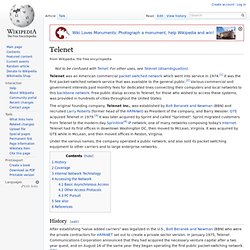

ARPANET. History[edit] Creation[edit] The first-generation IMPs were initially built by BBN Technologies using a rugged computer version of the Honeywell DDP-516 computer configured with 24kB of expandable core memory, and a 16-channel Direct Multiplex Control (DMC) direct memory access unit.[11] The DMC established custom interfaces with each of the host computers and modems.

In addition to the front-panel lamps, the DDP-516 computer also features a special set of 24 indicator-lamps showing the status of the IMP communication channels. Each IMP could support up to four local hosts, and could communicate with up to six remote IMPs via leased lines. The network connected one computer in Utah with three in California. Misconceptions of design goals[edit] Common ARPANET lore posits that the computer network was designed to survive a nuclear attack.
Merit Network. Merit Network, Inc., is a nonprofit member-governed organization providing high-performance computer networking and related services to educational, government, health care, and nonprofit organizations, primarily in Michigan.[1] Created in 1966, Merit operates the longest running regional computer network in the United States.

Organization[edit] Original Merit logo, c. 1968. Tymnet. Tymnet was an international data communications network headquartered in Cupertino, California that used virtual call packet switched technology and X.25, SNA/SDLC, ASCII and BSC interfaces to connect host computers (servers) at thousands of large companies, educational institutions, and government agencies.

Users typically connected via dial-up connections or dedicated asynchronous connections. CYCLADES. The CYCLADES packet switching network (French pronunciation: [siklad]) was a French research network created in the early 1970s.

It was developed to explore alternatives to the ARPANET design and to support network research generally. The experiences with the network had influences on the design of Internet protocols. The network was sponsored by the French government, through the Institut de Recherche en lnformatique et en Automatique (IRIA), the national research laboratory for computer science in France (now known as INRIA), which served as the co-ordinating agency. Several French computer manufacturers, research institutes and universities contributed to the effort. CYCLADES was designed and directed by Louis Pouzin. Telenet. Telenet was an American commercial packet switched network which went into service in 1974.[1] It was the first packet-switched network service that was available to the general public.[2] Various commercial and government interests paid monthly fees for dedicated lines connecting their computers and local networks to this backbone network.

Free public dialup access to Telenet, for those who wished to access these systems, was provided in hundreds of cities throughout the United States. Under the various names, the company operated a public network, and also sold its packet switching equipment to other carriers and to large enterprise networks. History[edit] After establishing "value added carriers" was legalized in the U.S., Bolt Beranek and Newman (BBN) who were the private contractors for ARPANET set out to create a private sector version. X.25.
X.25 network diagram.

X.25 is an ITU-T standard protocol suite for packet switched wide area network (WAN) communication. An X.25 WAN consists of packet-switching exchange (PSE) nodes as the networking hardware, and leased lines, plain old telephone service connections or ISDN connections as physical links. X.25 is a family of protocols that was popular during the 1980s with telecommunications companies and in financial transaction systems such as automated teller machines. X.25 was originally defined by the International Telegraph and Telephone Consultative Committee (CCITT, now ITU-T) in a series of drafts[1] and finalized in a publication known as The Orange Book in 1976.[2] While X.25 has, to a large extent, been replaced by less complex protocols, especially the Internet protocol (IP), the service is still used and available in niche and legacy applications. History[edit] X.25 is one of the oldest packet-switched services available. BITNET. BITNET was a cooperative USA university computer network founded in 1981 by Ira Fuchs at the City University of New York (CUNY) and Greydon Freeman at Yale University.[1] The first network link was between CUNY and Yale.

The requirements for a college or university to join BITNET were simple: Lease a data circuit (phone line) from a site to an existing BITNET node.Buy modems for each end of the data circuit, sending one to the connecting point site.Allow other institutions to connect to a site without chargeback. National Science Foundation Network. The National Science Foundation Network (NSFNET) was a program of coordinated, evolving projects sponsored by the National Science Foundation (NSF) beginning in 1985 to promote advanced research and education networking in the United States.[1] NSFNET was also the name given to several nationwide backbone networks that were constructed to support NSF's networking initiatives from 1985-1995.

Initially created to link researchers to the nation's NSF-funded supercomputing centers, through further public funding and private industry partnerships it developed into a major part of the Internet backbone. Larry Smarr on Building Mosaic. Doug Van Houweling: Building the NSFNet. Katie Hafner on the history of the ARPANET project.